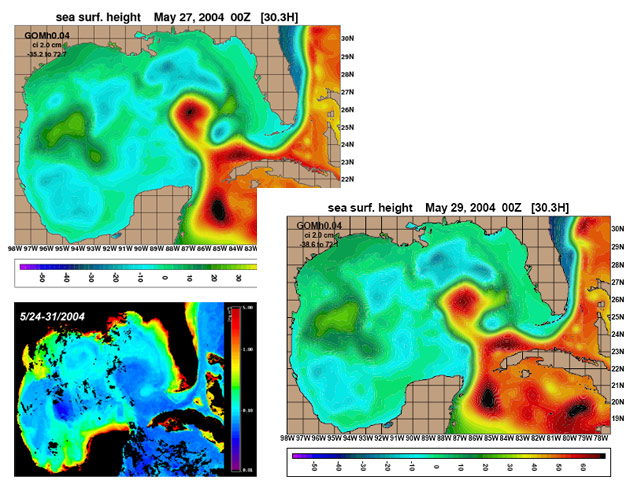Strong oceanic flows form a continuous link between the Southern and Northern Atlantic through the Caribbean Sea and the Gulf of Mexico. The Loop Current (LC) forms the origin of the Gulf Stream and it owes its unique shape to the Gulf geometry. It exhibits strong variability in extension and overall “shape”. At one extreme (“young” stage), the LC has an almost direct path to the Florida Current, causing the shear in the flow to set up a quasi-permanent clockwise recirculation known as the Cuban Vortex. At the other extreme (“extended” stage), it intrudes into the Gulf of Mexico, forming an intense clockwise flow as far north as 29°N, near the shelf-break of the Northern Gulf of Mexico (see NGoM-HYCOM model domain). Transition between these extremes is usually achieved through the shedding of anticyclonic rings that travel westward. Occasionally Loop Current-Mississippi River plume interactions have been observed / simulated, marked by the removal of Mississippi River waters along the LC front all the way to the Straits of Florida.
Intrusions of the Loop Current on the West Florida Shelf and indirect effects on shelf circulation in the Gulf of Mexico have also been studied. Eddies traveling around the LC front play a role in the ring shedding process (see below). They also promote the connectivity among remote coastal ecosystems, such as coral reefs, as they can travel by upstream reefs south of the Yucatan peninsula to downstream reefs in the Florida Keys (see Eddies in the Straits of Florida).
GoM plots provided by Pat Hogan and Ole-Martin Smedstad, Naval Research Lab - Stennis Space Center Satellite data and composite image provided by Viva Benzon, RSMAS satellite group




